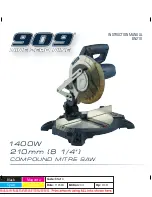
10
18V CORDLESS RECIPROCATING SAW
EN
instructions in reverse order.
WARNING:
Blade teeth are very sharp. Always
wear protective gloves. For best cutting results
ensure you use a saw blade suited to the material and
cut quality you need.
2. FOOTPLATE ADJUSTMENT
The pivot foot plate (6) tilts in order to keep as much of
its surface in contact with the work surface. To adjust,
hold saw firmly and pivot footplate to desired position.
(See Fig. B1)
If you need to reduce the cutting capacity of your tool
(depth of cut), the pivot foot plate (6) may be adjusted
as follows. Loosen the footplate adjustment knob
(3) on the underside of the front housing. Slide the
pivoting footplate to the required position. Tighten the
footplate adjustment knob and check that the footplate
is firmly latched. (See Fig. B2)
BEFORE PUTTING INTO OPERATION
1. BEFORE USING YOUR CORDLESS TOOL
WARNING!
The charger (not included) and
battery pack (not included) are specially
designed to work together so do not attempt to use any
other devices. Never insert or allow metallic objects
into your charger or battery pack connections because
of an electrical failure and hazard will occur.
2. TO REMOVE OR INSTALL BATTERY PACK (SEE FIG. C1,
C2)
Press the battery pack release button and remove the
battery pack from the saw. (See Fig. C1) After recharge
slide the battery pack into saw’s battery port. A simple
push and slight pressure will be sufficient. (See Fig.
C2)
The accessories of battery pack and charger are NOT
included in RD2960.9 delivery.
OPERATION
1. SAFETY ON/OFF SWITCH
Your switch is locked off to prevent accidental starting.
Depress lock-off button then on/off switch and release
lock-off button. Your switch is now on. (See Fig. E) To
switch off just release the on/off switch.
The speed of the blade can be adjusted by the pressure
you apply to the switch. To increase the speed, apply
more pressure to the switch. To decrease the speed,
apply less pressure.
2. HAND GRIP AREAS (SEE FIG. F)
Always hold your saw firmly with both hands when
operating.
3. FLUSH CUTTING
It is possible to make cuts extremely close to floors,
walls and other difficult areas. Insert the blade shank
into the blade clamp with the blade teeth facing up
(opposite to normal working position). This will make
cuts closer to the work surface (See Fig. G). Using
special flexible blades insert the blade into the blade
clamp with the blade teeth facing down (normal
working position). It will allow flush pipe cutting (See
Fig. H).
4. WOOD CUTTING
Always ensure the work-piece is firmly clamped to
prevent movement. For easier control use low speed to
start cutting, then increase to correct speed.
5. METAL CUTTING
This saw has different metal cutting capacities
depending upon the type of blade being used and
metal being cut.
ALWAYS
clamp the work down to prevent it from
slipping.
Use a finer blade for ferrous metals and a coarse blade
for non-ferrous metals.
When cutting thin gauge sheet metals, ALWAYS clamp
wood on both sides of the sheet. This will give you a
clean cut without excess vibration or tearing of the
metal.
DO NOT
force the cutting blade. Forcing the blade will
reduce blade life and cause the blade to break.
NOTE:
We recommend that you spread a thin film of oil
or other coolant along the line of cut ahead of the saw.
This will allow easier operation and help extend blade
life. When cutting aluminum, use kerosene.
6. POCKET CUTTING
(Soft materials only. Do not plunge
cut in metal surfaces.)
Mark the pocket or internal hole to be cut out. Insert
the special cutting blade with blade teeth facing down
and clamp securely. Angle the saw so that the back
edge of the blade guard is resting on the work surface
(see Fig. I & Fig. J). Use a slow speed to start the cut
to avoid breaking the blade but increase to correct
speed once the cut has started. With the blade guard
held firmly against the work surface, start a slow but
controlled upward swing of the saw. The blade will cut






























